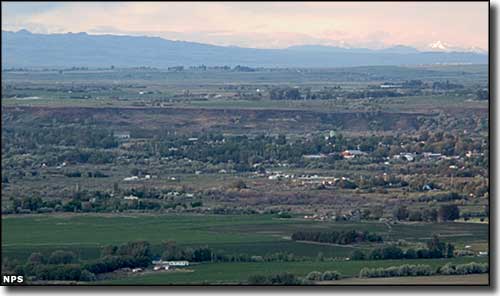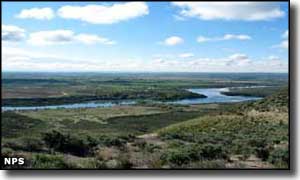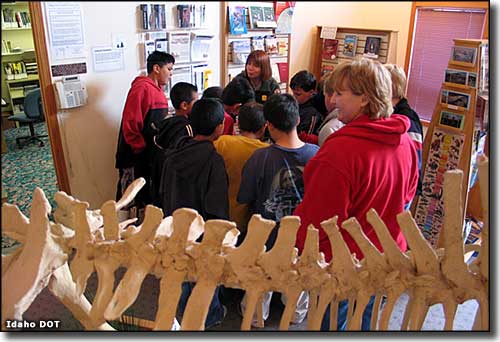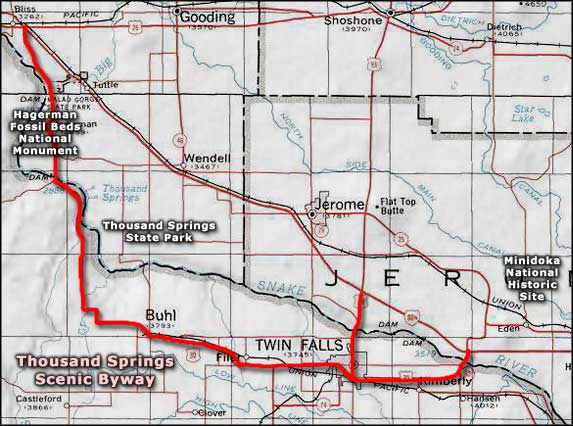 |
Hagerman Fossil Beds National Monument |
 Hagerman Valley, site of Hagerman Fossil Beds National Monument |

Scientists from the Smithsonian Institute conducted excavations here (beginning in 1929) that continue to demonstrate the importance of this archaeological site to the world. 30 complete Hagerman Horse fossils and portions of the fossilized skeletal remains of more than 200 other Hagerman Horses have been found. Hagerman Fossil Beds is also the site of the world's richest find of late Pliocene epoch fossils (3-4 million years ago). The fossilized remains of more than 220 species of animals and plants have been found in the rocks here. Hagerman Horse Quarry, a National Natural Landmark, is recognized as one of the six most important sites on Earth in regards to the fossil history of horses. The fossil record here spans about 500,000 years, representing an entire paleontological ecosystem of wetlands, riparian zones and grassland savannas. Many of the species found at Hagerman are the last of their kind before they went extinct during the Ice Ages. Beginning around 17 million years ago, volcanic activity in the area laid down layers of basalt and created the Snake River Plain. 3.5 million years ago, the Hagerman Valley was mostly a wet and forested flood plain teeming with vertebrate and invertebrate life. Water flows in the area created deep box canyons in the hard volcanic materials. Hot and cold springs popped out between the layers of rock and all that action taken together contributed to the fossilization of organic materials in the ground. Then came the Ice Ages. Near the end of the last Ice Age, Lake Bonneville was formed in northeastern Utah and about 14,300 years ago, the lake waters breached the surrounding ridges and flooded catastrophically down the Snake River Valley. Evidence of that flood is seen in the gouging of the canyons and the piles of house-sized boulders and enormous sand bars left behind. The main route of the Oregon National Historic Trail crosses the southern portion of Hagerman Fossil Beds. It's not known if any of the original travelers on that route were aware of the fossils but wagon ruts can still be seen at the Oregon Trail Overlook parking lot. The National Park Service Visitor Center is located across the street from Hagerman High School on US Highway 30. The Visitor Center offers fossil exhibits, a discovery corner and a small theater showing an information DVD about the fossil beds. Seasonally, the center also offers regularly scheduled tours with park rangers. From Memorial Day to August 31, the Visitor Center is open every day from 9 am to 6 pm. Hours cut back in September and by September 29, the Visitor Center will only be open Thursday through Monday from 9 am to 5 pm (and closed Tuesdays and Wednesdays). The Visitor Center is also closed for all Federal holidays except Memorial Day, July 4th and Labor Day. |
 The Museum at the Visitor Center, Hagerman Fossil Beds National Monument  Hagerman Fossil Beds National Monument area map |
|
|
 |
| Index - Arizona - Colorado - Idaho - Montana - Nevada - New Mexico - Utah - Wyoming National Forests - National Parks - Scenic Byways - Ski & Snowboard Areas - BLM Sites Wilderness Areas - National Wildlife Refuges - National Trails - Rural Life Advertise With Us - About This Site - Privacy Policy |
|
Upper photo courtesy of Cliff & Jean Dickey, National Park Service Small photo courtesy of the National Park Service Photo of the Hagerman Fossil Beds Museum courtesy of Idaho DOT. Area map courtesy of National Geographic Topo! Text Copyright © by Sangres.com. All rights reserved. |